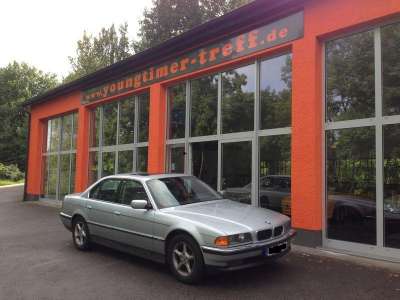 The BMW 750i as a youngtimer car
The BMW 750i as a youngtimer car
The E38 series was the 3rd edition of the 7 Series BMW. More specifically, the BMW 750i . Built from 1994 to 2001 with some innovations in automotive engineering. A built-in navigation system with a screen on which you can also watch TV. The xenon headlights, parking distance control to name a few things. Located in the luxury class, it was a direct competitor to the Mercedes S-Class of the W140 series. BMW was able to position itself very successfully on the market with this model, and there are many reasons for this. The E38 is now often described as timelessly elegant in terms of design. As the most beautiful 7 Series ever. This is probably mainly due to the fact that the rear lights of the predecessor were often criticized and the rear of the successor is not considered attractive.
Mercedes was heavily criticized for its S-Class, too wide, too long, too heavy. BMW, on the other hand, completely lived up to its reputation for sporty, elegant sedans. The twelve-cylinder consumes 4-5 liters less compared to the Mercedes’ V12. In addition, the BMW was designed to be more sporty in terms of driving behavior and did not seem so sedate. The E38 was a significant image boost for BMW and has now arrived in the area of youngtimers after 20 years.
The engine of the BMW 750i
The engine began with the 728i (193 hp) with an in-line six-cylinder. The two V8s with the 730i and 740i formed the backbone of the series. The engines in the previous model were only developed and introduced in 1992 and were then expanded in displacement to 3.5 liters for the 735i (238 hp) and to 4.4 liters (286 hp). Here the name remained 740i. The top model was the 12 cylinder with 5.4 liter displacement and 325 hp.
There was a diesel from 1996, the 725 tds with 143 hp, but things only became interesting in the diesel sector with the introduction of the 730d with common rail diesel technology. With its 184 hp and powerful torque, it was the engine of the future in all BMW models for the next few years. The 740d followed in 1999 as a V8 common rail diesel with 245 hp.
All petrol engines in this series are purely naturally aspirated and are considered very reliable. Mileages of over 400,000 km are not uncommon. Only the common rail diesels are afflicted with the typical problems, turbocharger damage or defective diesel pumps. This usually leads to expensive repairs, and the entire fuel system often has to be replaced because the finest chips have accumulated there and destroy the new parts in a short time.
THE EQUIPMENT OF THE BMW 750I
The 7 Series is usually very lavishly equipped; electric seat adjustment, climate control, navigation system, parking distance control, etc. are always present, especially in the top models. The parking distance sometimes causes problems, the other electrical helpers usually work well. Leaks in the air conditioning system are of course always an issue as we get older.
The body has a few problem areas with rust, the tailgate is a troublesome issue here. A stainless tailgate is almost never found. The bottom of the doors are still prone to damage, so it’s worth taking a look here too. The tank is also a problem; metal tanks usually don’t last 15 years. Even if the car has been very well maintained, rust on the tank is a big problem. The entire suspension of the wheels, axles and steering deteriorates over the years and kilometers. There is no explicit problem here, but it is worth checking closely.
Overall, a very solid car, a budding youngtimer in the upper class segment whose prices are currently bottoming out. Good used ones are not that cheap and are already sought after by collectors. A price increase for the BMW 750i as a youngtimer car can be expected soon .

